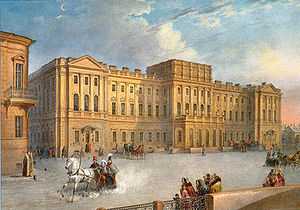State Council (Russian Empire)

The State Council (Russian: Госуда́рственный сове́т; IPA: [gəsʊˈdarstvʲɪnɨj sɐˈvʲɛt]) was the supreme state advisory body to the Tsar in Imperial Russia.
18th century
Early Tsars' Councils were small and dealt primarily with the external politics.
Peter I of Russia introduced the Secret Council. Catherine I of Russia introduced the Supreme Secret Council. Its role varied during different reigns.
Peter III of Russia created the Imperial Council on May 20, 1762 ("Императорский Совет"), or, formally "The Council at the Highest Court" ("Совет при высочайшем дворе"). It was dismissed shortly after the succession of Catherine II of Russia.
1810–1917
The State Council was established by Alexander I of Russia in 1810 as part of Speransky's reforms. Although envisaged by Speransky as the upper chamber of the Russian parliament, it was actually an advisory legislative body composed of people whom the tsar could trust. The number of members varied at different periods. Upon its establishment in 1810 there were 35 members; in 1890 there were 60. The main duty of the Council was the preliminary investigation, promulgation and abrogation of laws.
There were four departments of the Council: Legislative; Civil and Ecclesiastical Administration; State Economy; and Industry, Science and Commerce. Each department had its own presiding officer (State Secretary) and met separately to discuss matters assigned to their departments. There were also plenary sessions of the whole Council presided over by the Chairman of the State Council.
The Council as a whole examined projects of law proposed by the ministers who were ex-officio members. The majority of their sessions concerned the budget and state expenditures but they would examine anything submitted to them. They had no authority to propose changes to the law, to examine anything that was not submitted to them for examination or decision making authority. The Council only made recommendations to the monarch, who could support the majority, a minority, or disregard the Council's recommendations altogether, as he saw fit.

During 1906-1917, the status of the State Council was defined by the Russian Constitution of 1906. Its chairman was appointed by the Tsar. Half of its members were appointed by the Tsar from persons distinguished at civil and military service, and half by elections from various categories of society, separately:
- 56 seats from Zemstvo (1 from each guberniya),
- 18 seats from Assemblies of Nobility,
- 6 seats from the Russian Orthodox Church: 3 of them from white clergy, and 3 from black clergy (monks),
- 12 seats from stock exchange committees, chambers of commerce and business associations,
- 6 seats from the Russian Academy of Sciences,
- 2 seats from the Parliament of Finland, which refused to send delegates.
State Council was the upper house of the parliament, while the State Duma of the Russian Empire was the lower house. Compared to the contemporary British House of Lords and Prussian Herrenhaus, the Russian upper chamber was more democratically constituted, as half of its members were democratically elected from different sections of society, while the Herrenhaus consisted of hereditary peers, and the House of Lords consisted of Hereditary Peers, Non-Hereditary Peers (approved by a Commons-Lords Committee), and Clergy from Privileged Diocese.
The State Council ceased to exist after the February Revolution of 1917.
See also
| Wikimedia Commons has media related to State Council of the Russian Empire. |
- List of Chairmen of the State Council of Imperial Russia
- State Council of the Soviet Union
- State Council (Russia)
Sources
- Out of My Past: Memoirs of Count Kokovtsov; Hoover War Library Publications Number 6, Stanford University Press, 1935